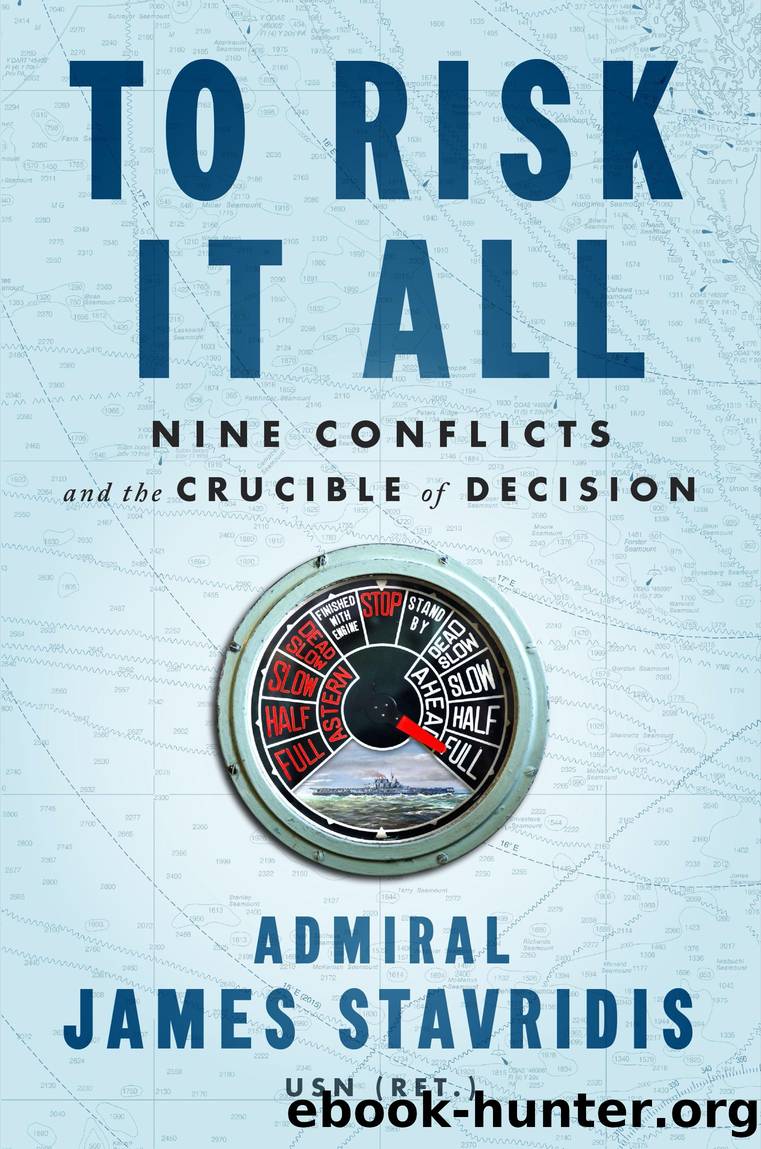To Risk It All by Admiral James Stavridis USN

Author:Admiral James Stavridis, USN [Stavridis, James]
Language: eng
Format: epub
Publisher: Penguin Publishing Group
Published: 2022-05-24T00:00:00+00:00
By nightfall on the twenty-fifth, the major actions of the Battle of Leyte Gulf had concluded. There were several codasâincluding the first use of kamikaze aircraft against the hapless Taffy escort carriers as Kurita retreatedâand a few more Japanese ships were sunk by US submarines. But the strategic results were clear: the US invasion of the Philippines was secure, and the fate of the Japanese Empire was sealed. Though the war would continue on land and sea through almost ten more months of increasingly desperate violence, the loss of the Philippines also meant the end of material imports from Japanâs remaining colonies in Southeast Asia. The Imperial Japanese Navy would never seriously challenge the US Navy again, and, from November 1944 until the atomic bombs fell in early August 1945, the Japanese war effort was slowly strangled to death while its citizens suffered terribly under strategic bombing campaigns.
Fortuitous as this outcome was for the war effort, it was lost on no one that the men and ships of the landing force, to say nothing of the additional months and lives a prolonged campaign might have consumed, had been saved in spite of Halseyâs decisions, not because of them. Questions, accusations, and recriminations began almost as soon as the shooting stopped and have continued through hundreds of histories written since. How had it come to pass that such a popular and successful commander had performed so badly at one of the most important moments of the war in the Pacific?
The questions only grew louder some weeks later, when Halsey chose not only to stay out at sea but also to keep the Third Fleet sailing close together in spite of (admittedly conflicting) reports of an impending typhoon. Halsey inadvertently steered his armada into the very center of the storm on December 17, and by the time the Third Fleet reemerged a day later, it had suffered three destroyers sunk, nine other ships damaged, more than a hundred aircraft destroyed on deck or washed away, and nearly eight hundred men drowned. Known to meteorologists as Typhoon Cobra and to the US Navy as Halseyâs Typhoon, this was the worst of Halseyâs many run-ins with storms at sea. Almost as soon as it was over, Halsey faced a court of inquiry in the presence of his boss, Admiral Nimitz; though he was found responsible for an âerror of judgment,â Halsey was not officially censured for his actions. Nimitz, known for leniency toward his subordinates, kept the popular and inspiring Halsey in the fightâbut command of the fleet at sea passed back to Admiral Spruance in January 1945.
Halsey rested until May, then resumed command of the fleet from Spruance. In June, he sailed the fleet into another typhoon, which caused further loss of aircraft and men. Once again, Halsey faced a court of inquiry; this one explicitly recommended he be removed from command, but Nimitz overruled the court and kept Halsey at sea. Halsey commanded the Third Fleet through the end of the war and once again launched airstrikes on the Japanese mainland.
Download
This site does not store any files on its server. We only index and link to content provided by other sites. Please contact the content providers to delete copyright contents if any and email us, we'll remove relevant links or contents immediately.
The Radium Girls by Kate Moore(10938)
The Templars by Dan Jones(4203)
100 Deadly Skills by Clint Emerson(4102)
Rise and Kill First by Ronen Bergman(4036)
The Doomsday Machine by Daniel Ellsberg(3747)
The Rape of Nanking by Iris Chang(3540)
Killing England by Bill O'Reilly(3473)
Hitler in Los Angeles by Steven J. Ross(3459)
Stalin by Stephen Kotkin(3102)
12 Strong by Doug Stanton(3067)
Hitler's Monsters by Eric Kurlander(2746)
Darkest Hour by Anthony McCarten(2658)
Blood and Sand by Alex Von Tunzelmann(2618)
The Art of War Visualized by Jessica Hagy(2430)
Hitler's Flying Saucers: A Guide to German Flying Discs of the Second World War by Stevens Henry(2310)
The Code Book by Simon Singh(2228)
The Second World Wars by Victor Davis Hanson(2140)
Babylon's Ark by Lawrence Anthony(2080)
Tobruk by Peter Fitzsimons(2070)
